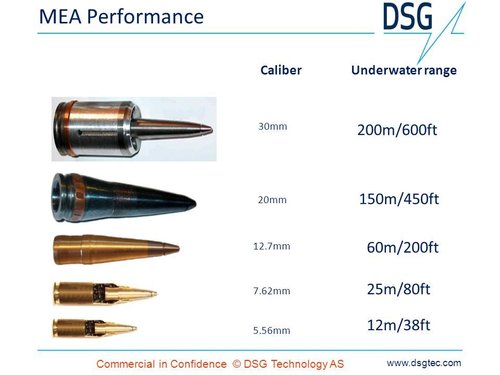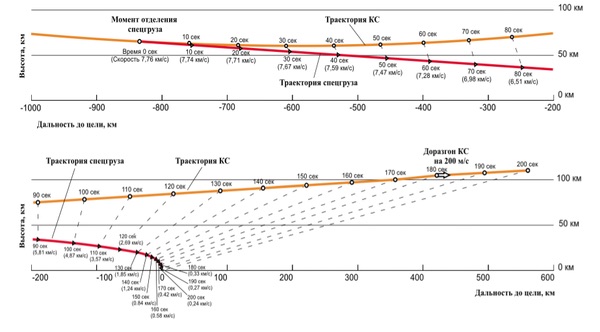Bombing missions
Okhotsimsky and Sikharulidze stated in their report that the shuttle would offer several advantages over intercontinental ballistic missiles, as well as so-called “global missiles,” the term the Russians used for rockets that would place nuclear weapons into orbit, after which they would de-orbit themselves and approach US territory from the south. The Soviet Union actually performed flight tests of such a system using the R-36 missile of the Yangel design bureau in the late 1960s and early 1970s (in the West this was known as a Fractional Orbit Bombardment System, or FOBS, and the Russian development of such a system may have led Okhotsimsky and Sikharulidze to assume that the Americans sought a similar capability.) While an ICBM needs just 30 or 40 minutes to reach its target, it spends much of its time at high altitudes (up to 800–1000 kilometers), making it easy to detect. In contrast, because it flies over the South Pole, the shuttle would need 70–80 minutes to reach its target, but flying at an altitude of 185–200 kilometers and approaching the Soviet Union from the south, it would be much harder to detect by Soviet early warning systems. An orbiting nuclear weapon is also easy to detect and its trajectory can be quite easily predicted, making it easy to take countermeasures. It also has a much lower strike accuracy, so they thought the shuttle would be better for this mission.
| Okhotsimsky and Sikharulidze then provided an alarming scenario for the American shuttle: a mission with the aim of dropping a “special payload” (in other words, a bomb) on Moscow. |
Okhotsimsky and Sikharulidze stated that the shuttle’s crew would make it possible to increase flexibility and even to call off the operation at the last moment. Strike accuracy would be increased by the ability to accurately determine the position of the orbiter before the de-orbit burn. With the help of the US Air Force’s Global Positioning System (GPS) then in development, that accuracy was expected to improve to 50 meters by 1981, and to 10 meters by 1984.
Okhotsimsky and Sikharulidze then provided an alarming scenario for the American shuttle: a mission with the aim of dropping a “special payload” (in other words, a bomb) on Moscow. The shuttle would enter the atmosphere at an altitude of 110 kilometers some 17 minutes after the de-orbit burn at 30 degree northern latitude. Four minutes after entry interface, at an altitude of 67 kilometers and with the orbiter at 47 degrees north, it would drop the bomb, which would hit its target about three to four minutes later at a speed varying between 200 and 500 meters per second. Detection would be made even more difficult by the fact that the orbiter and the bomb would be enveloped by a cloud of ionized gas at altitudes between 45 and 75 kilometers which cannot be penetrated by radio signals. Meanwhile, the orbiter would “turn in such a way that its lift would be aimed upwards with a roll angle of about –30°.” This would enable it to “come out of its dive and perform a lateral manoeuvre” to place it on a trajectory back to Vandenberg. Not having enough speed to reach the launch site, it would fire its Orbital Maneuvering System (OMS) engines (ideally at an altitude of about 100 kilometers) to provide a delta-V of about 200 meters per second. Exiting the atmosphere at a speed of 7.2 kilometers per second at 61 degrees north, the orbiter would reach a maximum altitude of 120 kilometers and then begin its final descent to Vandenberg. In contrast to the initial dive, which would take just 7.5 minutes, this gradual descent would take about 35 minutes.
Illustration from the IPM study showing the shuttle’s dive into the atmosphere and subsequent re-boost maneuver. The light line represents the trajectory of the shuttle and the dark line that of the “special payload”. |
One major problem with the scenario portrayed by Okhotsimsky and Sikharulidze was that the shuttle did not have a bomb bay on the bottom of the spacecraft. Instead, it had a payload bay with large doors mounted on its top that could not be opened during reentry. They did not address this issue in their report.
Okhotsimsky and Sikharulidze expected the shuttle to be used to strike “major administrative and military-industrial complexes,” the sudden destruction of which would offer the “attacking side” a major advantage. The shuttle could also be used to destroy mobile targets or “new targets of high military importance detected at the last moment.”






